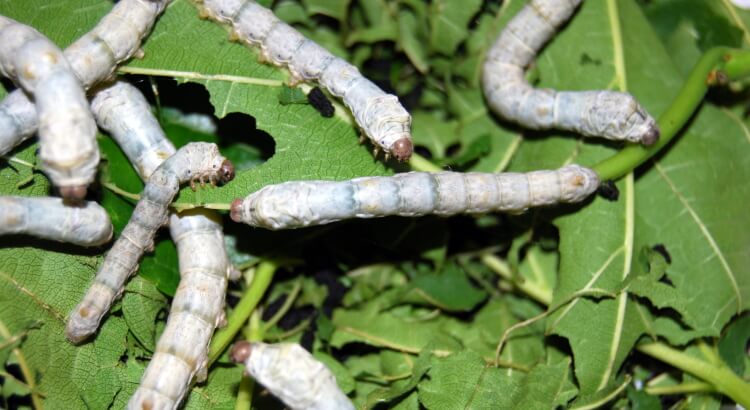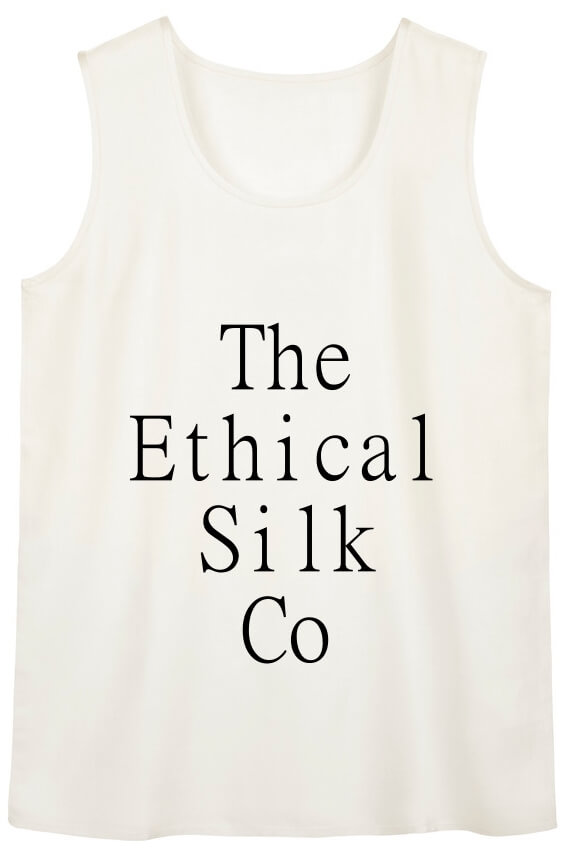How Can Silk Be Ethical?
When we first found The Ethical Silk Company, we had no idea there was such a thing as “ethical silk”. Traditionally, the extraction of silk from silkworms involves processes that end the life of the worms; a technique developed in 1991 in India makes it possible to extract the silk without killing the insects.This process, as it doesn’t end their life, is considered more ethical by some people and is part of a non violence philosophy of life.
Silk extraction starts by cultivating the silkworm, even when several insects produce silk only some can be used for extraction, mainly the Bombyx mori and the Mulberry silk moth. The silkworms are cultivated in mulberry leaves and once they start pupating in their cocoons, they are dissolved in boiling water so that individual long fibres can be extracted and fed into the spinning ree. I know what you are thinking: boiling water? Eww.

In what has been called “Peace silk”, marketed under the name of Ahimsa silk, the fiber is extracted after the worm has completed metamorphosis and emerged from the cocoon. Since the cocoons are where the silk is, they wait for the moth to fly away and then start processing the empty cocoons to make the fabric. Each cocoon is checked to make sure there are no moths inside.
Ahimsa silk was created by Kusuma Rajaiah in 1991 and was commercialized after ten years of additional research.
We met Eva Power, from The Ethical Silk Co, a manufacturer of bedding, scarves and other items made with Peace silk and she told us about her company and the specifics of her products.
Full interview with Eva Power
How did you decide to start the Ethical Silk Co?
Growing up my mother always slept on silk and swore by it. She used an old silk skirt and wrapped it around her pillow and felt she always slept better on it. I’ve family in India and my aunt would send home beautiful silk to us so I became a fan at an early age. It was through my mum’s encouragement that I began to look into producing silk pillowcases and cot sheets for babies. I always wanted to be my own boss so I began looking into the production end of things. I had limited capital so I knew I would have to start (very) small but that suited me. It was a case of ‘testing the waters’ for the first few years but the fact I had so many returning customers showed me I was onto something that could really grow.

Why Ahimsa Peace Silk? What made you choose this as your source and how do you believe this helps the world of fashion be more ethical?
Being a total novice regarding silk production I watch a documentary that showed the silk worms being boiled alive in order to extract the silk. this didn’t sit well with me so i did more research and found Ahimsa silk / Peace silk and was very intrigued. After seeing samples of, and falling in love with the feel and look of this animal friendly silk I decided I had found my silk. It was very important to me to find a tailoring unit that treated it’s workers fairly. I just felt that if I was going to run a business it had to be run a certain way and be something I could be wholly proud of. Our products are now tailored in a fair trade unit in the Indian Himalayas, run by Eternal Creation. I also decided to pledge 10% of company profits to charity (Focus Ireland (5%) and Jeevan Jyothi AIDS Centre (5%)). I feel businesses have a certain social responsibility and it is also an added incentive for me to keep pushing things further.
In my opinion ahimsa silk is a superior quality to the shiny/satiny silk available. It’s softer with a more natural subtle sheen. This was an added bonus though, I primarily wanted Ahimsa silk because it is eco-friendly. It upset me that the creature that give us this beautiful fabric are boiled alive in the process just to enable a greater yield of silk yarn. As far as relating this to the world of fashion, I feel it all comes down to a person’s values and conscience.
What is your favorite feature of silk?
My favourite feature of silk is it’s temperature regulating qualities. It’s amazing how something so light can both cool you down and warm you up. Years ago I spent some time travelling in Asia and always brought a silk sleeping bag liner with me. It really cooled me down in hot weather (when the idea of sleeping under anything felt wrong) and likewise I used it camping at high altitude,along with other blankets too, but it really made the difference.
How can consumers easily spot fake silk?
While in India I was given the tip of taking a thread of the silk and burning it to establish whether it is real or fake. if the thread of silk burns away to nothing the silk is real, if there is a remnant leftover it means there is something synthetic in it.
Can you really sleep better when using silk in your linens?
From feedback from my customers (I have a lot of return customers so that’s always a good sign) and my own personal use, I really find you sleep better using silk. I’m not sure what exactly to put it down to but I believe the temperature regulation is a major factor along with the fact silk doesn’t attract dust mites and is hypoallergenic. I find all natural fabrics are much more comfortable to wear so I suppose this extends to what you sleep on.
What is the best way to take care of silk products to make them last?
I machine wash my own silk on a gentle cycle (20 or 30 degrees) using a little non-bio detergent. After the spin I iron it from damp and find it dries through this and comes out the nicest. You don’t have to iron it immediately but just at some stage in the day. I’ve been using my Ahimsa silk pillowcases for 5 years now and they’re still going strong.
How did you find out about the Himalaya Tailoring Centre (Eternal Creation) and why did you decide to use them as your manufacturing facility?
It was really important to me to have our products made in a fairtrade tailoring unit. As I am running things remotely I need to be sure the tailors are getting well paid and treated fairly. Using a certified fair trade unit gives me the confidence in the tailoring unit standards, coupled with fantastic tailoring standards. I found Eternal Creation through Source Fellowship 500 and sent them samples to make up and we took things from there.
How is the relationship between the headquarters and the manufacturers? How hard is it to operate at a distance?
I don’t find operating at a distance to be too taxing, it is what it is. My manufacturer and the tailoring unit are fantastic keeping me up to speed on how orders are progressing. I suppose the main drawback is not being able to see things personally during each stage of the process and that taking a trip out is a big undertaking, especially with young kids at home.
Why should I buy your products?
Our products are a touch of luxury but also something exceptionally practical that last for years. The silk alone is of exceptional quality with a beautiful matt pearl finish, unlike other shiny mulberry silk available, and the benefits of sleeping on this natural material make our products thoughtful and unique gifts for yourself and others. Coupled with this, the ethical nature of our manufacturing and our pledge to give 10% profits to charity (Focus ireland – 5% and Jeevan Jyothi AIDS Hospice 5%) means our products continue to benefit on a wider scale.
We thank Eva for her interview and invite you to check out The Ethical Silk Co’s website.
Where in the world?
Resources
Learn how the traditional system works:
An Indian woman explains why she likes Ahimsa Silk:
A good video about the life cycle of a silkworm:
Want to learn more?
Your Email:
